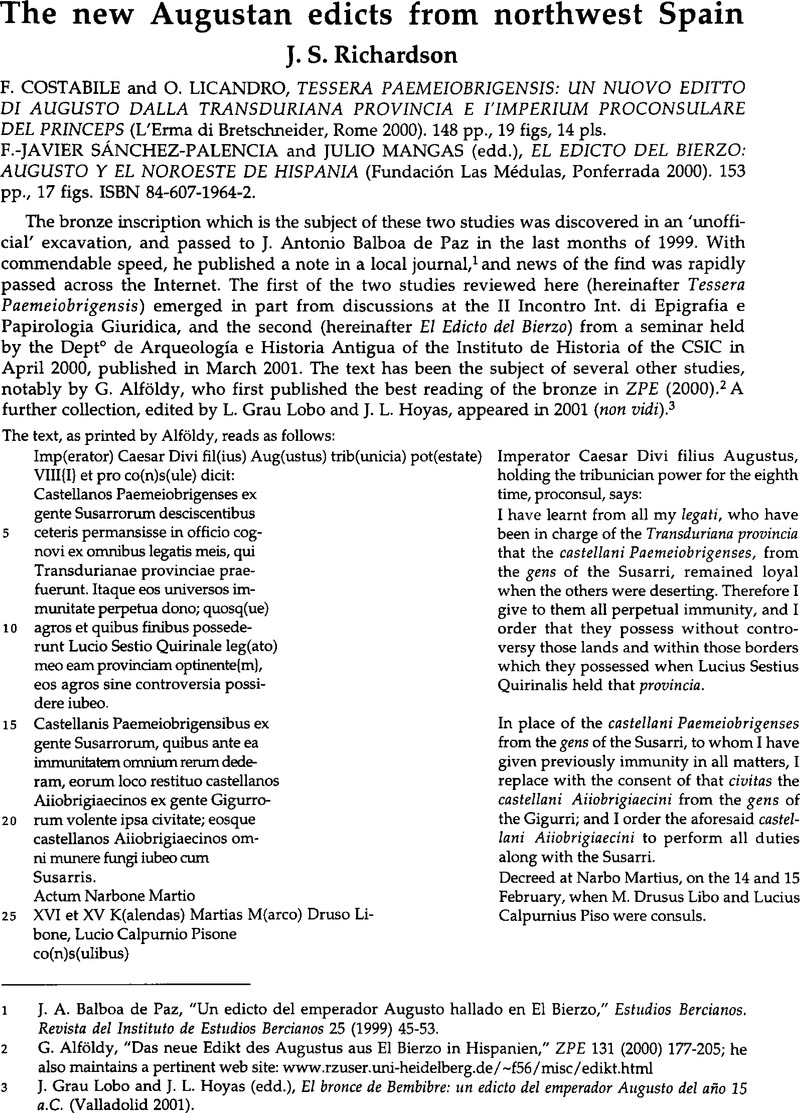Published online by Cambridge University Press: 16 February 2015

1 de Paz, J. A. Balboa, “Un edicto del emperador Augusto hallado en El Bierzo,” Estudios Bercianos. Revista del Instituto de Estudios Bercianos 25 (1999) 45–53 Google Scholar.
2 Alföldy, G., “Das neue Edikt des Augustus aus El Bierzo in Hispanien,” ZPE 131 (2000) 177–205 Google Scholar; he also maintains a pertinent web site: www.rzuser.uni-heidelberg.de/~f56/misc/edikt.html
3 Lobo, J. Grau and Hoyas, J. L. (edd.), El bronce de Bembibre: an edicto del emperador Augusto del año 15 a.C. (Valladolid 2001)Google Scholar.
4 CIL I2 614 (= ILLRP 514).
5 Couselo, J. Ferro and Fernandez, J. Lorenzo, “La tessera hospitalis de Castromao,” Boletin Auriense 1 (1971) 9–19 Google Scholar (=AE 1972.282).
6 Lloris, M. Beltrán, “Una celebración de ludi en territorio de Gallur, Zaragoza,” in XIV Cong. Nac. de Arqueología (Vitoria 1975) (Zaragoza 1982) 1061–70Google Scholar. This is now believed to be a commemoration of some monument erected by Sex. Arinius Ludus ( Rodà, I., “Bronces romanos de la Hispania Citerior,” in Los bronces rom?nos en España [Exh. cat., Madrid 1990] 78)Google Scholar.
7 Barja, P. López, “La provincia Transduriana,” 31–46 Google Scholar, and Gómez-Pantoja, J. and González, F. Martín, “Notas sobre el edicto del Bierzo a la luz de otras constituciones,” 123–38Google Scholar.
8 Mangas, J., “ Castellum, gens y ciuitas en el Edicto de Augusto (15 a.C),” 47–62 Google Scholar; Orejas, A., Sastre, I., Sánchez-Palencia, F. J. and Plácido, D., “El edicto de Augusto del Bierzo y la primera organización del Noroeste peninsular,” 63–112 Google Scholar; Fernández, E. García, “Immitnitas y attributio,” 113–22Google Scholar.
9 Supra n.8.
10 Thus P. and Cn. Scipio from 218 to 212 B.C. collected money to pay their soldiers from local inhabitants (Liv. 21.61.6-11; 23.48.5), and P. Scipio, the future Africanus, levied Stipendium from his allies for the same purpose in 206 (Liv. 28.25.9-15; 28.29.12; 28.34.11).
11 Supra n.8.
12 Licandro, O., “Il proconsulate del principe e le province,” in Tessera Paemeiobrigensis 65–103 Google Scholar; Gómez-Pantoja and Martín González (supra n.7).
13 Syme, R., “ Imperator Caesar: a study in nomenclature,” Historia 7 (1958) 184 Google Scholar.
14 The earliest instance in Claudius' letter to the Hymnodoi of Hypaepa of A.D. 41 (IGRR IV 1608 = Oliver, Greek constitutions no. 21), where he styles himself άνθύπ[ατος (1.18). The milestone from the via Augusta near Barcelona (CIL II 6242, 6324a) cited by Licandro, [Tessera Paemeiobrigensis 66)Google Scholar is from the reign of Caracalla, not that of Claudius (see now IRC 1185).
15 Alföldy (supra n.2) 192 cites several examples.
16 CIL VI 1033.
17 Alföldy (supra n.2) 192. The inscription from the obelisks may be found, with the normal supplement, at ILS 91.
18 Praenomina written out in full are very rare in the Republican period. In ILLRP (index Xlla), Degrassi notes 10 cases, apart from those in verse inscriptions, of which only one, on a curse tablet, is of a common Roman praenomen (Tito Paconio, on ILLRP 1150).
19 El Edicto del Bierzo 20 and fig. 7.
20 Costabile, F., “I problemi di storia provinciale romano-iberica,” in Tessera Paemeiobrigensis 39–62 Google Scholar; P. Lopez Barja in El Edicto del Bierzo (supra n.7)
21 Supra n.2.
22 Thus ILS 103 (of Augustan date); CIL XII 3167 (early 2nd c); CIL II 1970 (mid-2nd c).
23 Liv. 28.2.15.
24 Tessera Paemeiobrigensis 25-35.
25 Rodger, A., “ Attractio inversa in the edict of Augustus from El Bierzo,” ZPE 133 (2000) 266–70Google Scholar.